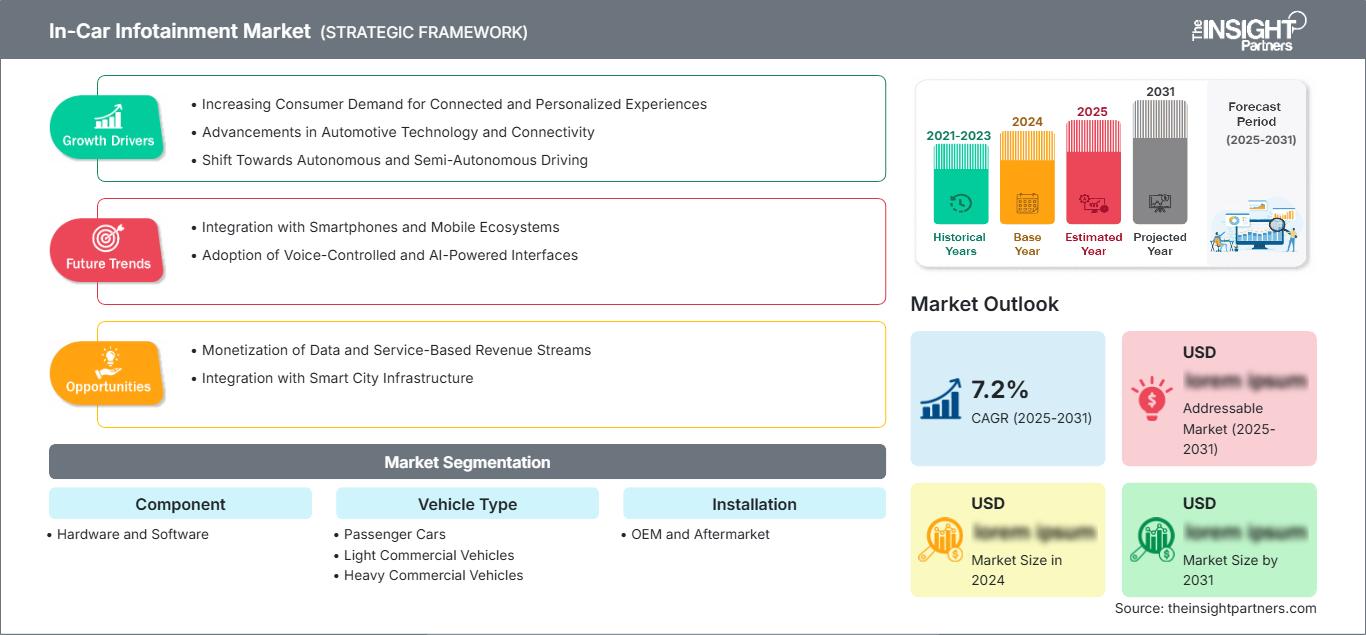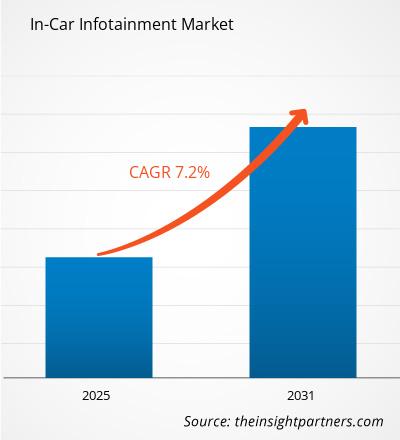Der Markt für In-Car-Infotainment wird voraussichtlich zwischen 2025 und 2031 eine durchschnittliche jährliche Wachstumsrate (CAGR) von 7,2 % verzeichnen, wobei die Marktgröße von XX Millionen US-Dollar im Jahr 2024 auf XX Millionen US-Dollar im Jahr 2031 anwachsen wird.
Der Bericht ist nach Komponenten (Hardware und Software), Fahrzeugtypen (Pkw, leichte Nutzfahrzeuge und schwere Nutzfahrzeuge) und Installation (OEM und Aftermarket) segmentiert. Die globale Analyse ist weiter auf regionaler Ebene und nach den wichtigsten Ländern aufgeschlüsselt. Der Bericht bietet den Wert in USD für die oben genannte Analyse und Segmente.
Zweck des Berichts
Der Bericht „In-Car-Infotainment-Markt“ von The Insight Partners zielt darauf ab, die aktuelle Situation und das zukünftige Wachstum sowie die wichtigsten treibenden Faktoren, Herausforderungen und Chancen zu beschreiben. Dadurch erhalten verschiedene Geschäftsinteressenten Einblicke, beispielsweise:
- Technologieanbieter/-hersteller: Um die sich entwickelnde Marktdynamik zu verstehen und die potenziellen Wachstumschancen zu kennen, sodass sie fundierte strategische Entscheidungen treffen können.
- Investoren: Um eine umfassende Trendanalyse hinsichtlich der Marktwachstumsrate, der finanziellen Marktprognosen und der Chancen entlang der Wertschöpfungskette durchzuführen.
- Regulierungsbehörden: Um Richtlinien und Überwachungsaktivitäten auf dem Markt zu regulieren, mit dem Ziel, Missbrauch zu minimieren, das Vertrauen der Investoren zu wahren und die Integrität und Stabilität des Marktes aufrechtzuerhalten.
Marktsegmentierungskomponente für Infotainment im Auto
- Hardware und Software
Fahrzeugtyp
- Pkw
- Leichte Nutzfahrzeuge
- Schwere Nutzfahrzeuge
Installation
- OEM und Aftermarket
Geografie
- Nordamerika
- Europa
- Asien-Pazifik
- Süd- und Mittelamerika
- Naher Osten und Afrika
Sie erhalten kostenlos Anpassungen an jedem Bericht, einschließlich Teilen dieses Berichts oder einer Analyse auf Länderebene, eines Excel-Datenpakets sowie tolle Angebote und Rabatte für Start-ups und Universitäten.
Markt für In-Car-Infotainment: Strategische Einblicke

-
Holen Sie sich die wichtigsten Markttrends aus diesem Bericht.Dieses KOSTENLOSE Beispiel umfasst Datenanalysen, die von Markttrends bis hin zu Schätzungen und Prognosen reichen.
Wachstumstreiber für Infotainmentsysteme im Auto
- Steigende Nachfrage der Verbraucher nach vernetzten und personalisierten Erlebnissen: Die wachsende Nachfrage der Verbraucher nach Infotainmentsystemen im Auto, die nahtlose Konnektivität, Personalisierung und eine breite Palette an Multimediafunktionen bieten, ist ein wichtiger Treiber des Marktes. Verbraucher wünschen sich Fahrzeuge, die sich mit ihren Smartphones integrieren lassen, Echtzeitinformationen liefern und ein intensiveres und ansprechenderes Fahrerlebnis bieten, was die Einführung fortschrittlicher Infotainmentsysteme vorantreibt.
- Fortschritte in der Automobiltechnologie und Konnektivität: Rasante Fortschritte in der Automobiltechnologie, insbesondere in Bereichen wie Touchscreen-Displays, Spracherkennung und Hochgeschwindigkeits-Internetverbindung, ermöglichen die Entwicklung anspruchsvollerer und benutzerfreundlicherer Infotainmentsysteme im Auto. Die Integration dieser Technologien, gepaart mit verbesserter Rechenleistung und Speicherkapazität, steigert die Gesamtfunktionalität und Attraktivität von Infotainmentlösungen im Auto.
- Entwicklung hin zu autonomem und teilautonomem Fahren: Die anhaltende Entwicklung hin zu autonomem und teilautonomem Fahren ist ein wichtiger Treiber des Infotainmentmarktes für Fahrzeuge. Mit zunehmender Autonomie verändert sich die Rolle des Fahrers, und es besteht ein erhöhter Bedarf an ansprechenden und intuitiven Infotainmentsystemen, die die Passagiere während der Fahrt beschäftigen. Automobilhersteller investieren in fortschrittliche Infotainmentlösungen, um dieser Entwicklung gerecht zu werden und ein angenehmeres und produktiveres Fahrerlebnis zu bieten.
Zukünftige Trends im Infotainmentmarkt für Fahrzeuge
- Integration mit Smartphones und mobilen Ökosystemen: Die Integration von Infotainmentsystemen für Fahrzeuge mit Smartphones und mobilen Ökosystemen wie Apple CarPlay und Android Auto ist ein wichtiger Trend auf dem Markt. Verbraucher erwarten zunehmend eine nahtlose Integration zwischen ihren Fahrzeugen und persönlichen Geräten, die die Spiegelung von Apps, den Zugriff auf Sprachassistenten und die Steuerung verschiedener Fahrzeugfunktionen über ihr Smartphone ermöglicht. Dieser Trend verbessert das Benutzererlebnis und fördert die Einführung von Infotainmentlösungen im Auto.
- Einführung sprachgesteuerter und KI-gestützter Schnittstellen: Die Integration sprachgesteuerter und KI-gestützter Schnittstellen ist ein wachsender Trend im Infotainmentmarkt für Autos. Automobilhersteller integrieren fortschrittliche Spracherkennung, natürliche Sprachverarbeitung und künstliche Intelligenz, um eine intuitivere und freihändige Steuerung von Infotainmentfunktionen zu ermöglichen. Dieser Trend steht im Einklang mit der allgemeinen Verlagerung hin zu sprachbasierten Interaktionen und dem Wunsch nach sichereren, komfortableren Erlebnissen im Fahrzeug.
Marktchancen für Infotainment im Auto
- Monetarisierung von Daten und servicebasierten Einnahmequellen: Die enormen Datenmengen, die von Infotainmentsystemen im Auto generiert werden, bieten eine Möglichkeit zur Monetarisierung. Durch die Nutzung von Datenanalysen können Automobilhersteller und Technologieanbieter personalisierte Dienste, gezielte Werbung und abonnementbasierte Modelle anbieten, die zusätzliche Einnahmequellen generieren. Dieser datenbasierte Ansatz kann das Infotainment-Ökosystem im Auto transformieren und neue Geschäftsmodelle und Einnahmequellen für Marktteilnehmer schaffen.
- Integration in Smart-City-Infrastruktur: Die Integration von Infotainmentsystemen im Auto in Smart-City-Infrastrukturen wie Verkehrsmanagementsysteme, Parklösungen und Notfallnetzwerke bietet vielversprechende Möglichkeiten. Durch die nahtlose Vernetzung von Fahrzeugen mit dem urbanen Ökosystem können Automobilhersteller und Technologieunternehmen neue Mehrwertdienste erschließen, die Verkehrseffizienz verbessern und das Fahr- und Passagiererlebnis insgesamt optimieren. Die Zusammenarbeit mit Stadtverwaltungen und Infrastrukturanbietern ermöglicht die Entwicklung umfassender intelligenter Mobilitätslösungen.
Regionale Einblicke in den Markt für Infotainment im Auto
Die Analysten von The Insight Partners haben die regionalen Trends und Faktoren, die den Markt für In-Car-Infotainment im Prognosezeitraum beeinflussen, ausführlich erläutert. In diesem Abschnitt werden auch die Marktsegmente und die geografische Lage in Nordamerika, Europa, dem asiatisch-pazifischen Raum, dem Nahen Osten und Afrika sowie Süd- und Mittelamerika erörtert.
Umfang des Marktberichts zum Infotainment im Auto
| Berichtsattribut | Einzelheiten |
|---|---|
| Marktgröße in 2024 | US$ XX million |
| Marktgröße nach 2031 | US$ XX Million |
| Globale CAGR (2025 - 2031) | 7.2% |
| Historische Daten | 2021-2023 |
| Prognosezeitraum | 2025-2031 |
| Abgedeckte Segmente |
By Komponente
|
| Abgedeckte Regionen und Länder |
Nordamerika
|
| Marktführer und wichtige Unternehmensprofile |
|
Dichte der Marktteilnehmer für Infotainment im Auto: Auswirkungen auf die Geschäftsdynamik verstehen
Der Markt für In-Car-Infotainment wächst rasant. Die steigende Nachfrage der Endnutzer ist auf Faktoren wie veränderte Verbraucherpräferenzen, technologische Fortschritte und ein stärkeres Bewusstsein für die Produktvorteile zurückzuführen. Mit der steigenden Nachfrage erweitern Unternehmen ihr Angebot, entwickeln Innovationen, um den Bedürfnissen der Verbraucher gerecht zu werden, und nutzen neue Trends, was das Marktwachstum weiter ankurbelt.

- Holen Sie sich die Markt für In-Car-Infotainment Übersicht der wichtigsten Akteure
Wichtige Verkaufsargumente
- Umfassende Abdeckung: Der Bericht analysiert umfassend Produkte, Dienstleistungen, Typen und Endnutzer des Marktes für In-Car-Infotainment und bietet einen ganzheitlichen Überblick.
- Expertenanalyse: Der Bericht basiert auf dem umfassenden Verständnis von Branchenexperten und Analysten.
- Aktuelle Informationen: Der Bericht gewährleistet Geschäftsrelevanz durch die Berichterstattung über aktuelle Informationen und Datentrends.
- Anpassungsoptionen: Dieser Bericht kann an spezifische Kundenanforderungen angepasst werden und passt sich so optimal an die Geschäftsstrategien an.
Der Forschungsbericht zum Markt für In-Car-Infotainment kann daher dazu beitragen, die Branchensituation und die Wachstumsaussichten zu entschlüsseln und zu verstehen. Obwohl es einige berechtigte Bedenken geben mag, überwiegen die Vorteile dieses Berichts tendenziell die Nachteile.
- Historische Analyse (2 Jahre), Basisjahr, Prognose (7 Jahre) mit CAGR
- PEST- und SWOT-Analyse
- Marktgröße Wert/Volumen – Global, Regional, Land
- Branchen- und Wettbewerbslandschaft
- Excel-Datensatz
Aktuelle Berichte
Verwandte Berichte
Erfahrungsberichte
Grund zum Kauf
- Fundierte Entscheidungsfindung
- Marktdynamik verstehen
- Wettbewerbsanalyse
- Kundeneinblicke
- Marktprognosen
- Risikominimierung
- Strategische Planung
- Investitionsbegründung
- Identifizierung neuer Märkte
- Verbesserung von Marketingstrategien
- Steigerung der Betriebseffizienz
- Anpassung an regulatorische Trends






















 Kostenlose Probe anfordern für - Markt für In-Car-Infotainment
Kostenlose Probe anfordern für - Markt für In-Car-Infotainment